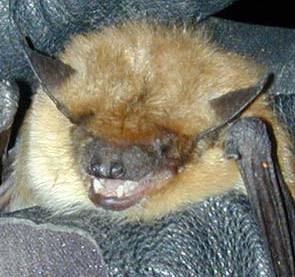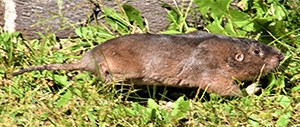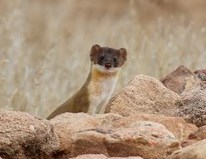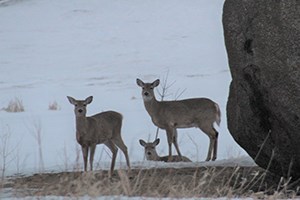What Animal All Brown Dark Brown Face Short Tail With No Stripes Short Ears

NPS Photograph
Prior to European expansion, large mammals such as bison, antelope, and elk roamed throughout the area that is now Pipestone National Monument. Today, over 25 species of primarily smaller mammals (rabbits, beavers, thirteen-lined ground squirrels) and deer call the Monument domicile. The following mammals have been recorded within the Monument'due south boundaries:

NPS/Congaree National Park
Opossum (Didelphis virginianus) Size: Appearance:
Diet: They volition scavenge roadkill, eat grass and nuts, hunt smaller animals, and dig through man containers such every bit dumpsters looking for food. It should be noted however, that they exercise humans a huge favor since they absolutely dearest to eat ticks, so try to avoid hit these animals if you see them while driving!
"Playing possum": This saying originated from the opossum's tendency to play expressionless in the face of predators in club to misfile them long enough to make an escape.
Their unique distinction: Opossums are the only marsupial in North American and Canada. Their babies are built-in the size of a honey bee, and crawl into their female parent'south pouch to finish developing.

Public Domain/USGS/Past Gilles Gonthier
Shrews (Soricidae)
Mutual names: Masked Shrew and Brusk-Tailed Shrew
Size: 2.5-4" long (masked), iv-5.5" long (short-tailed)
Appearance: Shrews take gray, brownish, or black velvety fur. Their faces are pointy and the masked shrew has a long, skinny tail while the curt-tailed, every bit the name implies, has a brusk tail.
Diet: Insects such equally ants and spiders every bit well as small mammals. Shrews accept a poisonous saliva that helps them dominate prey and tin cause astringent pain in humans for days.
An Impressive Metabolism: The eye of a shrew beats approximately 1200 times per minute, resulting in a feeding addiction that occupies their time both day and night.

NPS/PISP
Big Brown Bat (Eptesicus fuscus) Size:
Advent: Their fur is brown, their ears are short and blunt, and they have a wide mouth and snout.
Diet: Mostly they eat beetles, just they also prey on flies, wasps, moths, and other flying insects.
Do they really take bad eyesight? No, this is a myth. They have very good eyesight, merely hunt at dark when information technology'due south naturally more difficult to run across small, flight insects. That is when they use echolocation to accurately target their casualty.
Their Benefit to Humans is Enormous: Bats have voracious appetites, consuming upwards of i,000 insects each 60 minutes during the nighttime. In fact, ane colongy of 150 big brown bats can protect a farm from over thirty million rootworms every summertime.
White-Nose Syndrome: Millions of bats are existence killed in North America by this mucus, and there is a world-wide effort to terminate the spread of the disease. It is widely considered the worst wild animals illness in mod times.

NPS/AMIS
Raccoon (Procyon lotor) Size:
Appearance: Dark grayness and black fur, a ringed and bushy tail, black markings on the confront that strongly resemble a mask, and extremely dexterous hands.
Nutrition: Frogs, insects, crayfish, fruit, basics, and bird eggs. In urban areas, they are known for dumpster-diving and eating whatever food they tin can get their hands on.
Natural Problem Solvers: Raccoons are known for their intelligence. In the early 1900s, researchers put food in a box locked by several devices, including locks, latches, levers, hooks and more. The raccoons were able to figure out 11 of the 13 dissimilar mechanisms.
Fit for a President: President Calvin Coolidge had a pet racoon named Rebecca in the White Business firm. She frequently accompanied him on walks around the White Business firm grounds.

NPS/Denali National Park and Preserve
Dogs and Foxes (Canidae) Common names:
Size:
(Red fox)~15-20" tall at the shoulder, 3' long, viii-fifteen lbs.
(Coyote)~21-24" tall at the shoulder, 3.5-4.5' long, 15-50 lbs.
Appearance:
(Red fox)Rust-cerise fur with a white-tipped tail. Black legs, ears, and nose.
(Coyote)Gray and reddish-dark-brown fur with tall, pointed ears and narrow confront.
Sounds:
(Scarlet play a trick on)Barks and shrill screams
(Coyote)Short, high-pitched howls interspersed with yips and barks
Nutrition: Both of these animals eat meat, only will occasionally swallow vegetation also. In fact, foxes are ane of the few predators who will bury surplus food they gather for time to come use.
Den Mothers: Coyotes and foxes will construct dens for having pups under rocky crevaces, thickets, or expanding the abandoned dens of other animals. Once their pups are weaned, they too will abandon the den.
Formidable Athletes: You take to exist quick to get away from both of these predators. A coyote can stitch to 40 mph and the cerise play a trick on can clear 15 feet in a single spring!

NPS/PIPE
Squirrels (Sciuridae) Mutual names:
Size:
(Woodchuck)sixteen-xx" long with half-dozen" tail, four-13 lbs.
(Xiii-lined ground squirrel)~xi" long (nose to tail), 4-nine oz. in weight.
(Pull a fast one on squirrel)~20" long with 8" tail, 1.5-ii lbs.
Appearance:
(Woodchuck)Grizzled brown fur with frosted-looking guard hairs and a bushy tail; short limbs with thick claws.
(Thirteen-lined basis squirrel)Brown with 13 alternating brown and tan stripes and spots running the length of its torso.
(Fox squirrel)Very large squirrel with cherry-red-greyness fur. They are the biggest tree squirrel in Minnesota.
Diet:
(Woodchuck)Vegetation, nuts, tree bawl, and small critters similar snails. Dissimilar other members of the squirrel family, they practise not coffin nutrient for future use.
(Xiii-lined ground squirrel)More often than not grass and seeds, but they will eat insects like crickets and caterpillars.
(Flim-flam squirrel)Mostly nuts, merely they will as well take advantage of mushrooms and maple seeds.
An Underground Network: Thirteen-lined footing squirrels build short, dead-end tunnels for emergencies and more elaborate burrows for nesting and hibernating. Woodchucks volition build split up chambes in their burrows as well - even for sanitary purposes. They are known to build one burrow for nesting/hibernating and another for going to the bath!

NPS/J. Borden
Pocket Gophers (Geomyidae) Size:
Appearance: Stout, burrowing rodents. They have chocolate-brown fur and a tapered, mostly bare tail. They have external cheek pouches (pockets) that they use to carry food, hence the name 'pocket' gopher. They have small, naked ears and large front end claws for digging.
Nutrition: Vegetation such every bit roots and tubers
A Rare Sight: Pocket gophers spend over 70% of their time hole-and-corner in burrows. They but emerge for food or for finding mates.
Notable Work Ethic: The average pocket gopher is capable of moving i ton of soil to the surface each year. The cached vegetation provides nutrient-rich soil over fourth dimension.

NPS/DENA
Beaver (Castor canadensis) Size:
Appearance: This semi-aquatic animal is the largest rodent in Due north America. The fur is nighttime brown with coarse outer hair and very fine inner hair. The tail is large, paddle-shaped, and flat. The hind feet are webbed, but the front claws are non. Their incisors are long, nighttime orange, and powerful.
Nutrition: Aquatic plants, leaves, roots, and tree bark
Skilled Engineers: They barbarous trees with their teeth and weave branches into watertight dams to create ponds. The lodges they create in the middle of these ponds can reach over six' high and be 40' long and are only reachable from underwater. A monogamous couple will live with their babies (kits) and yearlings in them throughout the wintertime.
A Tidy Species: Beavers will build a separate den in their social club for the specific purpose of drying off.
Three eyelids? Yes! Beavers accept an inner, transparent eyelid which they use similar goggles while swimming underwater.

NPS/PECO
Weasels and Skunks (Mustelidae)
Common names: Curt-Tailed Weasel, Mink, and Striped Skunk
Size:
Short-tailed weasel:7-xiv", two-five ounces in weight
Mink:12-eighteen", two-4 lbs.
Striped skunk:15-37", 3-ten lbs.
Advent:
Short-tailed weasel:Long and pocket-sized with a black-tipped tail. Their fur is brown with a white or xanthous underside. All of their fur, except the tip of the tail, turns white during winter.
Mink:Brownish fur with rounded ears. Their torso is long and their legs are curt. Unlike weasels, their fur remains brown in winter.
Striped skunk:1 of the most easily identified animals in the wild! They have blackness fur and a single white stripe between the eyes that breaks into two large white stripes along the back and bushy tail.
Nutrition:
Brusque-tailed Weasel:These deadly predators chase small birds, baby rabbits, mice, insects, and even carrion. They will ofttimes pare back skin as they eat, leaving it inside-out in one case they're done feeding.
Mink:Crayfish, lizards, mice, rabbits, frogs, and anything that lives in or well-nigh h2o!
Striped skunk:These critters are omnivores, but prefer mice, egges, insects, and sometimes fifty-fifty chickens.
Home of Opportunity: Minks, skunks, and weasels will dig burrows for their nests, apply rock or wood piles, hollow logs, and fifty-fifty have advantage of the abandoned burrows congenital past other animals.
Keep your distance! The skunk is well-known for the olfactory property it uses to deter predators, but many people don't realize it tin can spray from up to 10 feet abroad. It's best to give them plenty of infinite if you cross paths with one in the wild!

Public Domain/U.S. Fish and Wild fauna Service
Mice, Rats, Lemmings, and Voles (Cricetidae) Mutual names:
Size: All of the mice within the Monument are between v-10" long (including the tail). Meadow voles are roughly 5-seven" and muskrats boilerplate nearly 20" long. The mice and vole simply counterbalance a couple of ounces or less, only the muskrat comes in at 1.5-4 lbs.
Advent:
The mice:Many of the mice within the Monument tin exist difficult to distinguish from 1 another. One exception would exist the meadow jumping mouse, which has a very long tail, long hind feet for jumping, brusk forelimbs, and a dark dorsal band.
Meadow vole:A short-tailed, cylindrical torso with brown chestnut fur and gray undersides.
Muskrat:A cousin to the beaver, these large aquatic rodents look very similar, except they accept a long, rat-like, and virtually hairless tail. Their very circular bodies are supported by extremely brusque legs.
Nutrition:
The mice:Seeds, grasses, berries, and insects
Meadow vole:Plants, grains, tree bawl, roots and berries (especially cranberries!)
Muskrat:Mostly vegetarian (leaves, roots, cattails, fruit, etc.), just will eat fish, turtles, and snails.
Prairie Protection: The mice and voles take reward of the tallgrass prairie and construct nests in picayune burrows for protection. Muskrats will build beaver-similar lodges forth water banks, though they are smaller than beaver lodges and are made out of plants like cattails instead of branches and logs.

Public Domain/Credit: Tom Koerner, U.S. Fish and Wildlife Service
Hares and Rabbits (Leporidae) Common names:
Size:
White-tailed jackrabbit:i.5-2' long, v-10 lbs.
Eastern cottontail:12-16" long, 2-three lbs.
Appearance:
White-tailed jackrabbit:These hares are grayish-brown with a pale underside, but turn white everywhere except their ears in the winter (this only happens in northern climates). They have extremely long ears and powerfully long hind legs.
Eastern cottontail:A pocket-sized grayish-brownish rabbit with a rusty-looking patch on the back of its neck. The tail is white, like cotton wool.
Diet: Both of these mammals swallow a diversity of plants, seeds, and grasses. They will even resort to eating their own droppings as a source of protein.
The 'jackrabbit' is non a rabbit at all! Jackrabbits are really hares - the ascendant difference existence that their babies are built-in with their eyes open, ready to move, and already have fur. Rabbit newborns are bullheaded and naked.
Fun facts from the hare and rabbit family!
White-tailed jackrabbit:When startled, this hare tends to bound almost like a kangaroo, merely upon accelartion can attain xl mph in 10' leaps (compared to the eastern cottontail'due south 15 mph zig-zag).
Eastern cottontail:When these rabbits eat buckthorn, they cease up excreting a chemical from the constitute in their urine that turns blue in sunlight. So if you meet bluish snowfall, that'south probable the reason! This species is as well a prolific breeder - a single pair can produce 350,000 descendents in 5 years.

NPS/North. Barber
White-Tailed Deer (Odocoileus viginianus)
Size:
4-6' long, 2-3' tall at the shoulder, 85-130 lbs. (females/does), 100-300 lbs. (males/bucks)Appearance: Reddish-brown (summertime) or grayish-brown (winter) with a 12" white tail it lifts when running. Males have antlers they regrow annually. Immature fawns are light brown and covered in white spots.
Diet: Acorns, grass, tree leaves, wild grapes, shrubs, twigs, bark, corn, and soybeans.
Their Timing and Ours: These mammals are near active at dawn and dusk as they search for food - when many humans are leaving for work or driving home and visibility is poor, which is why then many collisions with deer occur. If you see one cross the road, call up that they are nigh never alone and at to the lowest degree one more than deer is probably not as well far behind!
Bank check Out These Manufactures for More Data:
Source: https://www.nps.gov/pipe/learn/nature/mammals.htm
Posted by: yoderpoeth1945.blogspot.com

0 Response to "What Animal All Brown Dark Brown Face Short Tail With No Stripes Short Ears"
Post a Comment